Triple Crown of Global Cooling Could Trigger Widespread Food Shortages and Famine (Updated 7/4/2011)
According to the University of California at Berkeley:Much like the earth, the Sun has many different layers that define its structure. Unlike the earth, the Sun is completely gaseous; there is no solid surface on the Sun. The Sun is a very active star. No matter when or where you look, the Sun is always doing something interesting. One of the most dramatic properties of the Sun's activity is the existence of a solar cycle, which is best seen in the pattern of sunspots. The number of sunspots on the Sun is not constant but varies significantly with a peak number showing up, approximately every 11 years. The Sun, thus, has a cycle of behavior which repeats every 11 years.The Earth is now entering a phase with unstoppable and dramatic global cooling, which will initiate a new Little Ice Age within the next decade. The cause of this cooling is the predicted, and now real, reduction in solar activity that we now can see. These conditions will persist during the next solar cycles. This will have a devastating effect on agriculture, lowering food production and increasing the risk of widespread famine. This will also increase the demand for fuel. [Global Cooling Is Now Imminent, Is Unstoppable and Will Be Severe!, Per Strandberg, March 18, 2008]It is not known exactly what causes this repeatable behavior but processes in the deep interior of the Sun, which generate magnetic field, are thought to be responsible.
Over the last 30 years scientists have developed theories to explain this behavior and improved observations from telescopes in space are providing much needed information to help track down the answer to this particular solar conundrum.
With the PDO now in its cool phase, solar activity the weakest in more than 100 years, and the prospect of a major climate-cooling volcanic eruption, actions to limit CO2 emissions should be shelved and preparations made for an extended period of global cooling that would pose far more danger to humankind than any real or imagined warming predicted by today’s climate models. The largest emitters of carbon dioxide are volcanic eruptions, forest and wild fires, and natural decomposition of plants and animals — this is a good thing, since there is a relatively stable and finite amount of both oxygen and carbon on this planet. If it weren’t for carbon dioxide, the earth could well be a frozen ball in space, and life, as we know it, would probably not be able to survive. Cold is far more threatening than the little extra warmth we experienced from the warm PDO during 1977 to 1998 — during that period crop yield decreased 30 percent and there was a 10 percent decrease in arable land. A cooling down to 'Dalton Minimum' temperatures or worse would lead to shortened growing seasons and large-scale crop failures. Food shortages would make worse the fact that more people die from cold than heat. The Triple Crown of Global Cooling:
- Cooling North Pacific sea surface temperatures (Pacific Decadal Oscillation or PDO),
- Extremely low solar activity, and
- Increased volcanic eruptions.
Implications of PDO, NAO, Glacial Fluctuations, and Sun Spot Cycles for Global Climate in the Coming Decades
In a Geological Society of America abstract (see following story), Dr. Don Easterbrook, Professor of Geology at Western Washington University, presented data showing we were in a global warming cycle from 1977 to 1998, at which time we entered into a new global cooling period that should last for the next three decades.The Pacific Ocean has a warm temperature mode and a cool temperature mode, and in the past century it has switched back and forth between these two modes every 25-30 years (known as the Pacific Decadal Oscillation or PDO). The PDO typically lasts 25-30 years and assures North America of cool, wetter climates during its cool phases and warmer, drier climates during its warm phases.
Back in 1977, the Pacific abruptly shifted from its cool mode (where it had been since about 1945) into its warm mode, and this initiated global warming from 1977 to 1998.
In 1998, the Pacific shifted back to its cool mode. In 2008, NASA satellite imagery confirmed that the Pacific Ocean had switched from the warm mode it had been in since 1977 to its cool mode, similar to that of the 1945-1977 global cooling period.
The establishment of the cool PDO, together with similar cooling of the North Atlantic Oscillation (NAO), virtually assures several decades of global cooling and the end of the past 30-year warm phase. It also means that the IPCC predictions of catastrophic global warming this century were highly inaccurate. Dr. Easterbrook also suggests that since the IPCC climate models are now so far off from what is actually happening, that their projections for both this decade and century must be considered highly unreliable.
The Truth About Global Warming
The overwhelming greenhouse gas is water vapor, 30 to 50 times more important than CO2.CO2 attributed to man is minuscule.
Yet government-paid scientists claim HUMAN CO2 is the primary climate driver and must be eliminated to save the earth.
The instrument temperature records since 1850 or so (until satellite measures started in the 1970s) which are used to prove AGW (human induced global warming) have been shown to be inaccurate, unreliable, and tainted by numerous errors.
Man is actually an insignificant producer of CO2, though he is prideful enough to think he is a major player.
The greatest amount of carbon dioxide is locked up in plants, rocks, and the oceans. It should not be surprising that these each contribute more CO2 emissions than any other sources. The largest emitters of carbon dioxide are volcanic eruptions, forest and wild fires, and natural decomposition of plants and animals. This is a good thing, since there is a relatively stable and finite amount of both oxygen and carbon on this planet. If it weren’t for carbon dioxide, the earth could well be a frozen ball in space, and life, as we know it, would probably not be able to survive.
- The biggest source of CO2 emissions is volcanic eruptions. At any given time, according to agencies such as the USGS, there are about 13-17 volcanoes erupting somewhere on Earth. Thankfully, ocean water has a great propensity for absorbing this gas, and as ice melts, as it has done for the past 11,000 years, it means that the oceans can take in a great deal more CO2.
- Next in line for emissions is forest and wild fires and the decomposition of plant life.
- The next biggest emitter of carbon dioxide is probably the ocean.
- The exact figures for the amount of CO2 released through the use of fossil fuels is hard to come by.
Global Cooling is Here
Evidence for Predicting Global Cooling for the Next Three DecadesBy Professor Don J. Easterbrook, Global Research
November 2, 2008
INTRODUCTION
Despite no global warming in 10 years and recording setting cold in 2007-2008, the Intergovernmental Panel on Climatic Change (IPCC) and computer modelers who believe that CO2 is the cause of global warming still predict the Earth is in store for catastrophic warming in this century.
IPCC computer models have predicted global warming of 1° F per decade and 5-6° C (10-11° F) by 2100 (Fig. 1), which would cause global catastrophe with ramifications for human life, natural habitat, energy and water resources, and food production. All of this is predicated on the assumption that global warming is caused by increasing atmospheric CO2 and that CO2 will continue to rise rapidly.
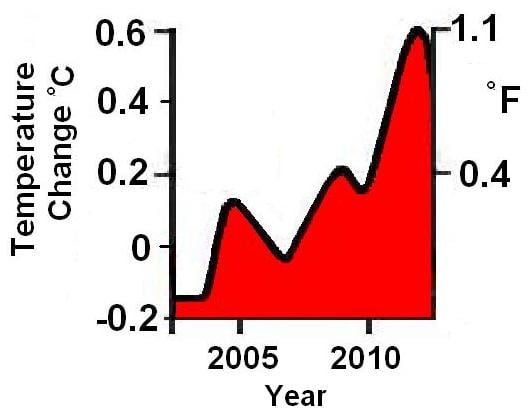
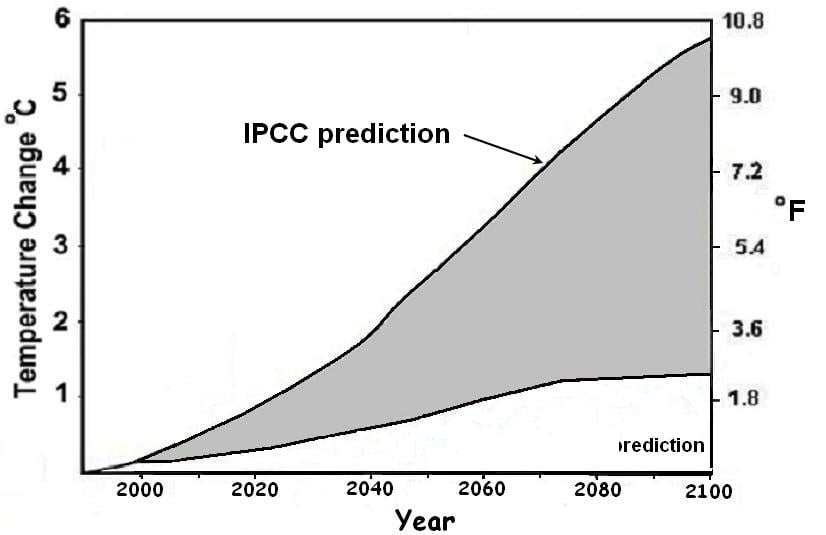
Figure 1. A. IPCC prediction of global warming early in the 21st century. B. IPCC prediction of global warming to 2100. (Sources: IPCC website)
However, records of past climate changes suggest an altogether different scenario for the 21st century. Rather than drastic global warming at a rate of 0.5 ° C (1° F) per decade, historic records of past natural cycles suggest global cooling for the first several decades of the 21st century to about 2030, followed by global warming from about 2030 to about 2060, and renewed global cooling from 2060 to 2090 (Easterbrook, D.J., 2005, 2006a, b, 2007, 2008a, b); Easterbrook and Kovanen, 2000, 2001).
Climatic fluctuations over the past several hundred years suggest ~30 year climatic cycles of global warming and cooling, on a general rising trend from the Little Ice Age.
PREDICTIONS BASED ON PAST CLIMATE PATTERNS
Global climate changes have been far more intense (12 to 20 times as intense in some cases) than the global warming of the past century, and they took place in as little as 20–100 years.
Global warming of the past century (0.8° C) is virtually insignificant when compared to the magnitude of at least 10 global climate changes in the past 15,000 years. None of these sudden global climate changes could possibly have been caused by human CO2 input to the atmosphere because they all took place long before anthropogenic CO2 emissions began. The cause of the ten earlier ‘natural’ climate changes was most likely the same as the cause of global warming from 1977 to 1998.

Figure 2. Climate changes in the past 17,000 years from the GISP2 Greenland ice core. Red = warming, blue = cooling. (Modified from Cuffy and Clow, 1997)
Climatic fluctuations over the past several hundred years suggest ~30 year climatic cycles of global warming and cooling (Figure 3) on a generally rising trend from the Little Ice Age about 500 years ago.
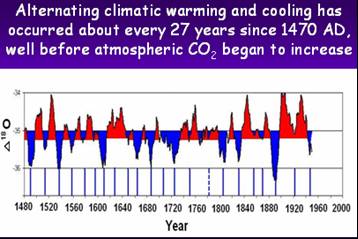
Figure 3. Alternating warm and cool cycles since 1470 AD. Blue = cool, red = warm. Based on oxygen isotope ratios from the GISP2 Greenland ice core.
Relationships between glacial fluctuations, the Pacific Decadal Oscillation, and global climate change.
After several decades of studying alpine glacier fluctuations in the North Cascade Range, my research showed a distinct pattern of glacial advances and retreats (the Glacial Decadal Oscillation, GDO) that correlated well with climate records. In 1992, Mantua published the Pacific Decadal Oscillation curve showing warming and cooling of the Pacific Ocean that correlated remarkably well with glacial fluctuations. Both the GDA and the PDO matched global temperature records and were obviously related (Fig. 4). All but the latest 30 years of changes occurred prior to significant CO2 emissions so they were clearly unrelated to atmospheric CO2.
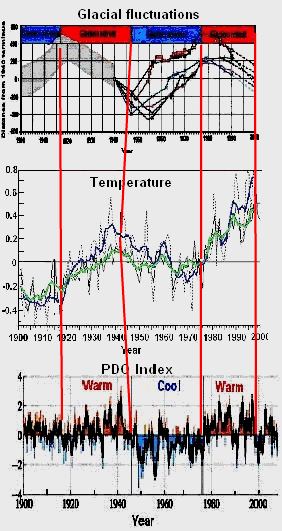
Figure 4. Correspondence of the GDO, PDO, and global temperature variations.
The significance of the correlation between the GDO, PDO, and global temperature is that once this connection has been made, climatic changes during the past century can be understood, and the pattern of glacial and climatic fluctuations over the past millennia can be reconstructed. These patterns can then be used to project climatic changes in the future.
Using the pattern established for the past several hundred years, in 1998 I projected the temperature curve for the past century into the next century and came up with curve ‘A’ in Figure 5 as an approximation of what might be in store for the world if the pattern of past climate changes continued. Ironically, that prediction was made in the warmest year of the past three decades and at the acme of the 1977-1998 warm period.
At that time, the projected curved indicated global cooling beginning about 2005 ± 3-5 years until about 2030, then renewed warming from about 2030 to about 2060 (unrelated to CO2—just continuation of the natural cycle), then another cool period from about 2060 to about 2090. This was admittedly an approximation, but it was radically different from the 1° F per decade warming called for by the IPCC. Because the prediction was so different from the IPCC prediction, time would obviously show which projection was ultimately correct.
Now a decade later, the global climate has not warmed 1° F as forecast by the IPCC but has cooled slightly until 2007-08 when global temperatures turned sharply downward. In 2008, NASA satellite imagery (Figure 6) confirmed that the Pacific Ocean had switched from the warm mode it had been in since 1977 to its cool mode, similar to that of the 1945-1977 global cooling period. The shift strongly suggests that the next several decades will be cooler, not warmer as predicted by the IPCC.
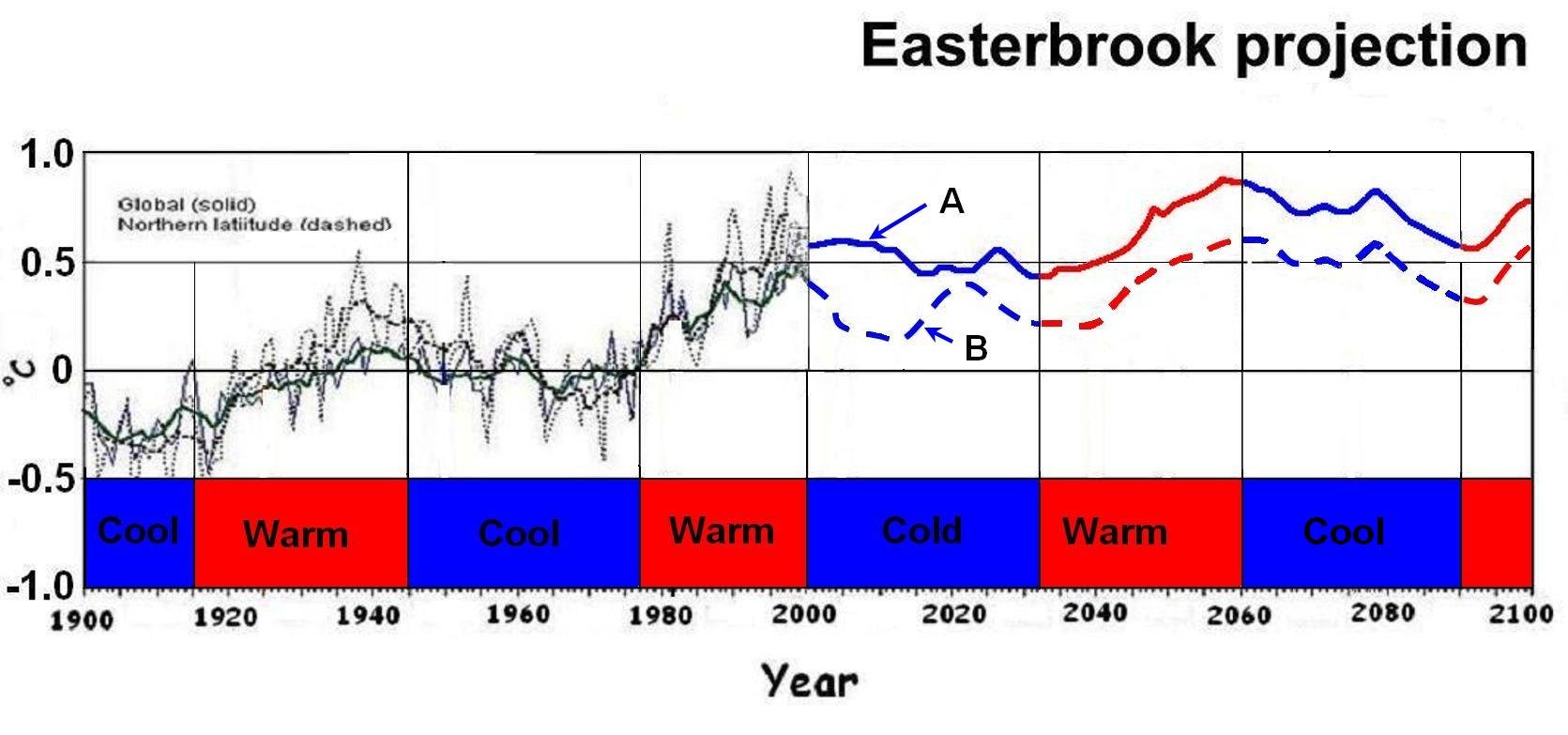
Figure 5. Global temperature projection for the coming century, based on warming/cooling cycles of the past several centuries. ‘A’ projection based on assuming next cool phase will be similar to the 1945-1977 cool phase. ‘B’ projection based on assuming next cool phase will be similar to the 1880-1915 cool phase. The predicted warm cycle from 2030 to 2060 is based on projection of the 1977 to 1998 warm phase and the cooling phase from 2060 to 2090 is based on projection of the 1945 to 1977 cool cycle.
Implications of PDO, NAO, GDO, and sun spot cycles for global climate in coming decades
The IPCC prediction of global temperatures, 1° F warmer by 2011 and 2° F by 2038 (Fig. 1), stand little chance of being correct. NASA’s imagery showing that the Pacific Decadal Oscillation (PDO) has shifted to its cool phase is right on schedule as predicted by past climate and PDO changes (Easterbrook, 2001, 2006, 2007).
The PDO typically lasts 25-30 years and assures North America of cool, wetter climates during its cool phases and warmer, drier climates during its warm phases. The establishment of the cool PDO, together with similar cooling of the North Atlantic Oscillation (NAO), virtually assures several decades of global cooling and the end of the past 30-year warm phase. It also means that the IPCC predictions of catastrophic global warming this century were highly inaccurate.
The switch of PDO cool mode to warm mode in 1977 initiated several decades of global warming. The PDO has now switched from its warm mode (where it had been since 1977) into its cool mode. As shown on the graph above, each time this had happened in the past century, global temperature has followed. The upper map shows cool ocean temperatures in blue (note the North American west coast). The lower diagram shows how the PDO has switched back and forth from warm to cool modes in the past century, each time causing global temperature to follow.
Comparisons of historic global climate warming and cooling over the past century with PDO and NAO oscillations, glacial fluctuations, and sun spot activity show strong correlations and provide a solid data base for future climate change projections.
The Pacific Ocean has a warm temperature mode and a cool temperature mode, and in the past century, has switched back forth between these two modes every 25-30 years (known as the Pacific Decadal Oscillation or PDO). In 1977 the Pacific abruptly shifted from its cool mode (where it had been since about 1945) into its warm mode, and this initiated global warming from 1977 to 1998.
The correlation between the PDO and global climate is well established. The announcement by NASA’s Jet Propulsion Laboratory that the Pacific Decadal Oscillation (PDO) had shifted to its cool phase is right on schedule as predicted by past climate and PDO changes (Easterbrook, 2001, 2006, 2007). The PDO typically lasts 25-30 years and assures North America of cool, wetter climates during its cool phases and warmer, drier climates during its warm phases. The establishment of the cool PDO, together with similar cooling of the North Atlantic Oscillation (NAO), virtually assures several decades of global cooling and the end of the past 30-year warm phase.
Figure 6. Switch of PDO cool mode to warm mode in 1977 initiated several decades of global warming. The PDO has now switched from its warm mode (where it had been since 1977) into its cool mode. As shown on the graph above, each time this has happened in the past century, global temperature has followed. The upper map shows cool ocean temperatures in blue (note the North American west coast). The lower diagram shows how the PDO has switched back and forth from warm to cool modes in the past century, each time causing global temperature to follow. Projection of the past pattern (right end of graph) assures 30 yrs of global cooling
Comparisons of historic global climate warming and cooling over the past century with PDO and NAO oscillations, glacial fluctuations, and sun spot activity show strong correlations and provide a solid data base for future climate change projections.
As shown by the historic pattern of GDOs and PDOs over the past century and by corresponding global warming and cooling, the pattern is part of ongoing warm/cool cycles that last 25-30 years.
The global cooling phase from 1880 to 1910, characterized by advance of glaciers worldwide, was followed by a shift to the warm-phase PDO for 30 years, global warming and rapid glacier recession. The cool-phase PDO returned in ~1945 accompanied by global cooling and glacial advance for 30 years.
Shift to the warm-phase PDO in 1977 initiated global warming and recession of glaciers that persisted until 1998.
Recent establishment of the PDO cool phase appeared right on target and assuming that its effect will be similar to past history, global climates can be expected to cool over the next 25-30 years. The global warming of this century is exactly in phase with the normal climatic pattern of cyclic warming and cooling and we have now switched from a warm phase to a cool phase right at the predicted time (Fig. 5)
The ramifications of the global cooling cycle for the next 30 years are far reaching―e.g., failure of crops in critical agricultural areas (it’s already happening this year), increasing energy demands, transportation difficulties, and habitat change. All this during which global population will increase from six billion to about nine billion.
The real danger in spending trillions of dollars trying to reduce atmospheric CO2 is that little will be left to deal with the very real problems engendered by global cooling.
CONCLUSIONS
Global warming (i.e, the warming since 1977) is over. The minute increase of anthropogenic CO2 in the atmosphere (0.008%) was not the cause of the warming—it was a continuation of natural cycles that occurred over the past 500 years.
The PDO cool mode has replaced the warm mode in the Pacific Ocean, virtually assuring us of about 30 years of global cooling, perhaps much deeper than the global cooling from about 1945 to 1977.
Just how much cooler the global climate will be during this cool cycle is uncertain. Recent solar changes suggest that it could be fairly severe, perhaps more like the 1880 to 1915 cool cycle than the more moderate 1945-1977 cool cycle. A more drastic cooling, similar to that during the Dalton and Maunder minimums, could plunge the Earth into another Little Ice Age, but only time will tell if that is likely.
Don J. Easterbrook is Professor Emeritus of Geology at Western Washington University. Bellingham, WA. He has published extensively on issues pertaining to global climate change. For further details see his list of publications
Triple Crown of Global Cooling Could Pose Serious Threat to Humanity
By Kirk Myers, Seminole County Environmental News ExaminerMay 19, 2010
The Triple Crown of Global Cooling:
- Cooling North Pacific sea surface temperatures (Pacific Decadal Oscillation or PDO),
- Extremely low solar activity, and
- Increased volcanic eruptions.
“Global warming” may become one of those quaint cocktail party conversations of the past if three key climate drivers [the Triple Crown of Global Cooling] — cooling North Pacific sea surface temperatures, extremely low solar activity, and increased volcanic eruptions — converge to form a “perfect storm” of plummeting temperatures that send our planet into a long-term cool-down lasting 20 or 30 years or longer.
“There are some wild cards that are different from what we saw when we came out of the last warm PDO [Pacific Decadal Oscillation] and entered its cool phase [1947 to 1976]. Now we have a very weak solar cycle and the possibility of increased volcanic activity. Together, they would create what I call the ‘Triple Crown of Cooling,’” says Accuweather meteorologist Joe Bastardi.If all three climate-change ingredients come together, it would be a recipe for dangerously cold temperatures that would shorten the agricultural growing season in northern latitudes, crippling grain production in the wheat belts of the United States and Canada and triggering widespread food shortages and famine.
Cool Pacific Decadal Oscillation
The Pacific Decadal Oscillation refers to cyclical variations in sea surface temperatures that occur in the North Pacific Ocean. (The PDO is often described as a long-lived El Niño-like pattern.) PDO events usually persist for 20 to 30 years, alternating between warm and cool phases. During these long periods there are sometimes short-interval phase switches that can last several years.
From 1977 to 1998, during the height of “global warming,” North America was in the midst of a warm PDO. Since then, we have experienced several short-duration PDO fluctuations between cool and warm.
But the PDO has once again resumed its negative cool phase, and, as such, represents the first climate driver in the Triple Crown of Cooling. With the switch to a cool PDO, we’ve seen a change in the El Nino/Southern Oscillation (ENSO), which alternates between El Nino (warm phase) and La Nina (cool phase) every few years. The recent strong El Nino that began in July 2009 is now transitioning to a La Nina, a sign of cooler temperatures ahead.
“We’re definitely headed towards La Nina conditions before summer is over, and we’re looking at a moderate to strong La Nina by fall and winter, which, as these La Ninas tend to persist in the cold PDO for two years, should bring us cooler temperatures over the next few years,” predicts Joe D’Aleo, founder of the International Climate and Environmental Change Assessment Project (ICECAP) and the first director of meteorology at the Weather Channel.He is not alone in his forecast. Bastardi also sees a La Nina just around the corner.
“I’ve been saying since February that we’ll transition to La Nina by the middle of the hurricane season. I think we’re already seeing the atmosphere going into a La Nina state in advance of water temperatures. This will have interesting implications down the road. La Nina will dramatically cool off everything later this year and into next year, and it is a signal for strong hurricane activity,” Bastardi predicts.The difference in sea surface temperature between positive and negative PDO phases is not more than 1 to 2 degrees Celsius, but the affected area is huge. So the temperature changes can have a big impact on the climate in North America.
In fact, as Dr. Roy Spencer points out, the warm-phase PDO lasting from 1977 to 1998 might explain most of the warming we experienced in the late 20th century.
“This is because a change in weather circulation patterns can cause a small change in global-average cloudiness. And since clouds represent the single largest internal control on global temperatures (through their ability to reflect sunlight), a change in cloudiness associated with the PDO might explain most of the climate change we’ve seen in the last 100 years or more,” he writes.Declining solar activity
Another real concern — and the second climate driver in the Triple Crown of Cooling — is the continued stretch of weak solar activity Earth is experiencing. We recently exited the longest solar minimum — 12.7 years compared to the 11-year average — in 100 years. It was a historically inactive period in terms of sunspot numbers. During the minimum, which began in 2004, we have experienced 800 spotless days. A normal cycle averages 485 spotless days.
In 2008, we experienced 265 days without a sunspot, the fourth-highest number of spotless days since continuous daily observations began in 1849. In 2009, the trend continued, with 261 spotless days, ranking it among the top five blank-sun years. Only 1878, 1901 and 1913 (the record-holder with 311 days) recorded more spotless days.
In 2010, the sun continues to remain in a funk. There were 27 spotless days (according to Layman’s sunspot count) in April and, as of May 19, 12 days without a spot. Both months exhibited periods of inexplicably low solar activity during a time when the sun should be flexing its “solar muscle” and ramping up towards the next solar maximum.
Why are sunspot numbers important? Very simple: there is a strong correlation between sunspot activity and global temperature. During the Dalton Minimum (1790 - 1830) and Maunder Minimum (1645 -1715), two periods with very low sunspot activity, temperatures in the Northern Hemisphere plummeted.
During the Dalton Minimum, the abnormally cold weather destroyed crops in northern Europe, the northeastern United States and eastern Canada. Historian John D. Post called it “the last great subsistence crisis in the Western world.” The record cold intensified after the eruption of Mount Tambora in 1815, the largest volcanic eruption in more than 1,600 years (see details below).
During the 70-year Maunder Minimum, astronomers at the time counted only a few dozen sunspots per year, thousands fewer than usual. As sunspots vanished, temperatures fell. The River Thames in London froze, sea ice was reported along the coasts of southeast England, and ice floes blocked many harbors. Agricultural production nose-dived as growing seasons became shorter, leading to lower crop yields, food shortages and famine.
If the low levels of solar activity during the past three years continue through the current solar cycle (Solar Cycle 24), which is expected to peak in 2013, we could be facing a severe temperature decline within the next five to eight years as Earth’s climate begins to respond to the drop-off in solar activity.
“The sun is behaving very quietly — like it did in the late 1700s during the transition from Solar Cycle 4 to Solar Cycle 5 — which was the start of the Dalton Minimum,” D’Aleo says. “If the official sunspot number reaches only 40 or 50 — a low number indicating very weak solar energy levels — during the next solar maximum, we could be facing much lower global temperatures down the road.”Volcanic eruptionsEven NASA solar physicist David Hathaway has said this is “the quietest sun we've seen in almost a century.”
"Since the Space Age began in the 1950s, solar activity has been generally high," Hathaway told NASA Science News. "Five of the ten most intense solar cycles on record have occurred in the last 50 years. We're just not used to this kind of deep calm."
Although the eruption of Iceland’s Mount Eyjafjallajokull volcano continues to raise havoc with air travel, it remains a relatively minor event by volcanic standards. Much of its ash cloud has stayed out of the stratosphere, where it would reflect sunlight, bringing cooler temperatures to the northern hemisphere.
Unfortunately, there is a very real chance Eyjafjallajokull’s much larger neighbor, the Katla volcano, could blow its top, creating the third-climate driver in the Triple Crown of Cooling. If Katla does erupt, it would send global temperatures into a nosedive, with a big assist from the cool PDO and a slumbering sun.
The Katla caldera measures 42 square miles and has a magma chamber with a volume of around 2.4 cubic miles, enough to produce a Volcanic Explosivity Index (VEI) level-six eruption — an event ten times larger than Mount St. Helens.
Katla erupts about every 70 years or so, most recently in 1918, often in tandem with neighboring Eyjafjallajokull, which is not a good sign.
According to Bastardi:
“The Katla volcano in Iceland is a game changer. If it erupts and sends plumes of ash and SO2 into the stratosphere, any cooling caused by the oceanic cycles would be strengthened and amplified.”Not a very encouraging outlook. Yet major eruptions throughout history bear witness to the deadly impact of volcanoes.Iceland’s President Olafur Grimsson says the eruption of Eyjafjallajoekull volcano is only a "small rehearsal.”
“The time for Katla to erupt is coming close . . . I don't say if, but I say when Katla will erupt,” Grimsson predicts. And when Katla finally erupts it will “create for a long period, extraordinary damage to modern advanced society.”
The Tambora eruption in 1815, the largest in 1,600 years, sent the earth’s climate into a deep freeze, triggering “the year without a summer.” Columnist Art Horn, writing in the Energy Tribune, describes the impact:
“During early June of 1815, a foot of snow fell on Quebec City. In July and August, lake and river ice were observed as far south as Pennsylvania. Frost killed crops across New England with resulting famine. During the brutal winter of 1816/17, the temperature fell to -32 in New York City.”And Katla, with its large magma chamber, would register high on the Volcanic Explosivity Index, if it were to erupt. When it unleashed its fury in the 1700s, the volcano sent temperatures into a tailspin in North America.
As Gary Hufford, a scientist with the Alaska Region of the National Weather Service, observes:
"The Mississippi River froze just north of New Orleans and the East Coast, especially New England, had an extremely cold winter.Global cooling: a life-threatening event"Katla could cause some serious weather changes. It depends on the duration of the eruption, and how high the ash gets blasted into the stratosphere.”
With the PDO now in its cool phase, solar activity the weakest in more than 100 years, and the prospect of a major climate-cooling volcanic eruption, actions to limit CO2 emissions should be shelved and preparations made for an extended period of global cooling that would pose far more danger to humankind than any real or imagined warming predicted by today’s climate models.
Says D’Aleo:
“Cold is far more threatening than the little extra warmth we experienced from 1977 to 1998 during the recent warm PDO. According to NASA, crop yield decreased 30 percent, and there was a 10 percent decrease in arable land during that period, which helped us feed many millions more of the earth’s population. A cooling down to Dalton Minimum temperatures or worse would lead to shortened growing seasons and large-scale crop failures. Food shortages would make worse the fact that more people die from cold than heat.
The Pacific Decadal Oscillation (PDO): Key to the Global Warming Debate?
Dr. Roy SpencerJuly 4, 2011
The Pacific Decadal Oscillation (PDO) is an internal switch between two slightly different circulation patterns that occurs every 30 years or so in the North Pacific Ocean. It was originally described in 1997 in the context of salmon production. It has a positive (warm) phase that tends to warm the land masses of the Northern Hemisphere, as well as a negative (cool) phase.
Like the El Nino and La Nina oscillation of the tropical Pacific (also called the El Nino – Southern Oscillation, or ENSO), the PDO represents two different average circulation states that the ocean-atmosphere system seems to have a difficult time choosing between. But whereas ENSO changes every few years, the PDO changes every thirty years or so. This long time scale makes the PDO a potential key player in climate change.
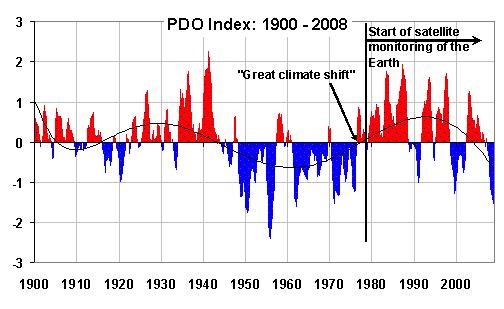
In fact, I now believe that the PDO is critical to our understanding of global warming. This is because a change in weather circulation patterns can cause a small change in global-average cloudiness. And since clouds represent the single largest internal control on global temperatures (through their ability to reflect sunlight), a change in cloudiness associated with the PDO might explain most of the climate change we’ve seen in the last 100 years or more.
For instance, after the “Great Climate Shift of 1977″ when the PDO went from its negative to positive phase, the Arctic region began to warm. Satellite monitoring of Arctic sea ice just happened to begin soon thereafter (in 1979), and as you probably know from the news media reports, the yearly summer melt season has seen a gradual loss of ice cover since then. In late 2007, the Northwest Passage opened, a rare event that allows ships to travel the relatively short distance between the Atlantic and Pacific Oceans through the Arctic.
But while the warming and loss of Arctic sea ice in the last 30 years is popularly attributed to mankinds’ production of carbon dioxide from fossil fuel use, similar events occurred in the 1920s and 1930s, with disappearing sea ice, changing wildlife patterns, and the opening of the Northwest Passage in 1939 and 1940. Arctic temperatures were just as warm then as they are now.
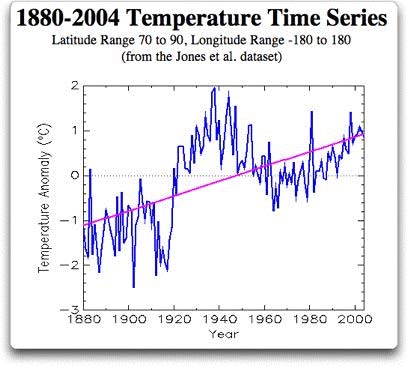
And now, as of late 2008, it looks like we might have entered into a new, negative (cooling) phase of the PDO. Only time will tell whether this pattern persists.
Cooling Climate: Winters are Getting Colder Across Ohio and the U.S.
Winters in the United States have gotten colder over the last 10 years. The reasons: a cooler Pacific Ocean (the cold phase of the Pacific Decadal Oscillation), a weak solar cycle and volcanic activity as the causes of the cooling.NewsNet5.com
July 6, 2011
The numbers don't lie. The observations don't lie. Winters in Ohio and the United States have gotten colder over the last 10 years. But you sensed that anyway, didn't you? (Especially after this last long, cold winter!)
Meteorologist & colleague Joe D'Aleo, from the website ICECAP.us, took a look at the winter statistics from the National Climatic Data Center (NCDC). What he found was startling. Since late 2001, the winter months of December, January and February have gotten colder at the second fastest 10-year rate since the late 1800s. On average, all nine official climate regions of the US have seen a wintertime temperature drop of 4.13 degrees F.
Ohio is part of the six-state Central Climate Region. That includes Illinois, Indiana, West Virginia, Kentucky and Tennessee. In this region, our temperatures have declined an impressive 5.82 degrees F since the winter of 2001/2002.
The largest decline was seen in the Northern Plains and the Western Great Lakes, where cold-season temperatures have plummeted up to 8.74 degrees F on average over the last 10 winters.
The snow pack across the Northern Hemisphere has also increased during this chilly period. This passed winter produced the third greatest snow extent (in square km) for the Northern Hemisphere since 1967. It finished behind only the winter of 2009/10 and 1977/78 and just ahead of the winter of 2007/08.
The reasons?
"Clearly, natural factors really can pack a punch," said Dr. Joe D'Aleo.
He sited a cooler Pacific Ocean (the cold phase of the Pacific Decadal Oscillation), a weak solar cycle and volcanic activity as the causes of the cooling.
Government-funded Scientist See Sunspot 'Hibernation' But No Ice Age
ReutersJune 15, 2011
Sunspot cycles -- those 11-year patterns when dark dots appear on the solar surface -- may be delayed or even go into "hibernation" for a while, a U.S. scientist said on Wednesday.
But contrary to some media reports, this does not mean a new Ice Age is coming, Frank Hill of the National Solar Observatory said in a telephone interview.
"We have not predicted a Little Ice Age," Hill said, speaking from an astronomical meeting in New Mexico. "We have predicted something going on with the Sun."
The appearance of sunspots helps predict solar storms that can interfere with satellite communications and power grids.
Hill and other scientists cited a missing jet stream, fading spots and slower activity near the Sun's poles as signs that our nearest star is heading into a rest period.
"This is highly unusual and unexpected," he said in a statement released on Tuesday. "But the fact that three completely different views of the Sun point in the same direction is a powerful indicator that the sunspot cycle may be going into hibernation."
That hibernation would not begin now, as the current sunspot cycle, the 24th, has recently passed its minimum. Hill and his colleagues pondered a slowdown in sunspot activity in the 25th cycle, expected sometime around 2019.
They also wondered whether this possible slowdown, or even a long cessation of sunspot activity, indicates an upcoming return of the Maunder Minimum, a 70-year sunspot drought seen from 1645-1715.
'HUGE LEAP'
They had no answer as to whether this might be true, and said nothing about whether the Maunder Minimum -- named for astronomer E.H. Maunder -- was related to a long cold period in Europe and other parts of the Northern Hemisphere known as the Little Ice Age.
How strong a connection is there between a Little Ice Age and a Maunder Minimum?
"Not as strong a connection as people would like to believe," Hill said by phone.
"The Little Ice Age actually lasted for hundreds of years, of which the Maunder Minimum was only a small segment ... My personal opinion is that there is only an anecdotal connection without a whole lot of scientific background behind it."
Several websites and blogs have argued that the potentially cooling influence of a lower level of sunspot activity could cancel out the warming caused by human activities that generate climate-warming greenhouse gases. Hill disputed this.
"In my opinion, it is a huge leap ... to an abrupt global cooling, since the connections between solar activity and climate are still very poorly understood," he said in an e-mail.
Scientists Predict Rare 'Hibernation' of Sunspots
AFPJune 15, 2011
US scientists say the familiar sunspot cycle seems to be entering a hibernation period unseen since the 17th century, a pattern that could have a slight cooling effect on global temperatures.
For years, scientists have been predicting the Sun would by around 2012 move into solar maximum, a period of intense flares and sunspot activity, but lately a curious calm has suggested quite the opposite.
The signs include a missing jet stream, fading spots and slower activity near the poles, said a trio of studies presented Tuesday at the annual meeting of the American Astronomical Society's Solar Physics Division in Las Cruces, New Mexico.
"This is highly unusual and unexpected," said Frank Hill, associate director of the National Solar Observatory's Solar Synoptic Network.
"But the fact that three completely different views of the Sun point in the same direction is a powerful indicator that the sunspot cycle may be going into hibernation."
Solar activity tends to rise and fall every 11 years or so. The solar maximum and solar minimum each mark about half the interval of the magnetic pole reversal on the Sun, which happens every 22 years.
Experts are now probing whether this period of inactivity could be a second Maunder Minimum, a 70-year period when hardly any sunspots were observed between 1645-1715 known as the "Little Ice Age."
"If we are right, this could be the last solar maximum we'll see for a few decades. That would affect everything from space exploration to Earth's climate," said Hill.
Solar flares and eruptions can send highly charged particles hurtling toward Earth and interfere with satellite communications, GPS systems and even airline controls.
Geomagnetic forces have been known to occasionally garble the world's modern gadgetry, and warnings were issued as recently as last week when a moderate solar flare sent a fiery coronal mass ejection in the Earth's direction.
EDITOR'S NOTE: The rest of this article is pure government propaganda, which blames man for global warming so that the global elite can impose carbon taxes on the people in order to fund their world government while at the same time reducing the world's population.
However, the temperature change associated with any reduction in sunspot activity would likely be minimal and not enough to offset the impact of greenhouse gases on global warming, according to scientists.
"Recent solar 11-year cycles are associated empirically with changes in global surface temperature of 0.1 Celsius," said Judith Lean, a solar physicist with the US Naval Research Laboratory.
If the cycle were to stop or slow down, the small fluctuation in temperature would do the same, eliminating the slightly cooler effect of a solar minimum compared to the warmer solar maximum. The phenomenon was witnessed during the descending phase of the last solar cycle.
This "cancelled part of the greenhouse gas warming of the period 2000-2008, causing the net global surface temperature to remain approximately flat -- and leading to the big debate of why the Earth hadn't (been) warming in the past decade," Lean, who was not involved in the three studies presented, told AFP.
Less sunspot activity means the Sun will radiate lower levels of energy, ultraviolet rays, solar wind and a weaker magnetic field, explained climate scientist and author Rasmus Benestad of the Norwegian Meteorological Institute.
"Historical data suggest that solar activity, however, only appears to have a weak effect on our climate," said Benestad.
A study in the March 2010 issue of Geophysical Research Letters explored what effect an extended solar minimum might have, and found no more than a 0.3 Celsius dip by 2100 compared to normal solar fluctuations.
"A new Maunder-type solar activity minimum cannot offset the global warming caused by human greenhouse gas emissions," wrote authors Georg Feulner and Stefan Rahmstorf, noting that forecasts by the Intergovernmental Panel on Climate Change forecast a maximum 4.5 degree Celsius rise by this century's end compared to the latter half of the 20th century.
"Moreover, any offset of global warming due to a grand minimum of solar activity would be merely a temporary effect, since the distinct solar minima during the last millennium typically lasted for only several decades or a century at most."
Other experts were skeptical about whether the latest data actually predict a long-term solar minimum.
"There is no compelling reason to think that the Sun is about to go into hibernation," said Yi-Ming Wang of the Naval Research Laboratory.
"On the other hand, we don't understand the solar dynamo well enough to make any reliable prediction about what cycle 25 will be like."
Big Solar Flare Portends Sun’s Return to Normal
Prepare for the Worst, Because Solar Storms Are About to Get Ugly
The Sun Is Acting Up Again
What Makes the Sun Flare
The 2012 Apocalypse — And How to Stop It
Discover the Earth’s Magnetic Personality
New Space Telescope Delivers First Mind-Blowing Video of the Sun
Scientists: Iceland's Grimsvotn volcano erupting (May 21, 2011)
Updated 5/21/11 (Newest Additions at End of List)
See also Generated Global Food Crisis
See also Man-Made Global Warming Hoax
See also Solar Storms and EMP Threats

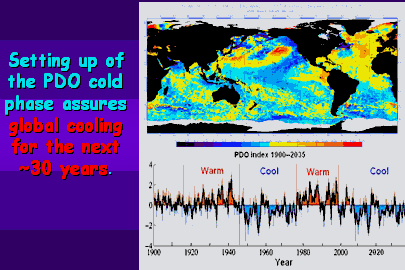






No comments:
Post a Comment